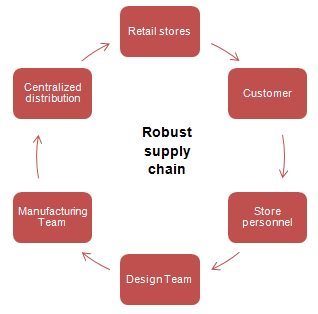Brand conscious urban Indians have been wowed by ZARA, Spanish fashion retailer, since its foray in India in 2010 in a Joint Venture with Trent, retail arm of Tata group. Some of us swear by ZARA merchandise which offers exquisite affordable luxury. But little did we know that Bloomberg Billionaire Index published in October, 2012 declared Amancio Ortega, founder and owner of ZARA, the world 3rd wealthiest billionaire, racing past Warren Buffett.
Amancio Ortega, promoter of Inditex, worlds largest fashion retailer markets 8 brands; ZARA is one of its flagship brands. Inditex was listed in Madrid Stock Exchange in May, 2001. Inditex stock has delivered a compounded annual growth rate of 52% in the last two years and a Return on Equity (ROE) of ~30%. Inditex retails its 8 brands through Exclusive Brand Outlets (EBO) of 6009 stores of which 1751 are ZARA stores. ZARA contributes to 65% of Inditex turnover with a retail footprint of only 29% of Inditex total stores. ZARA has played an instrumental role in elevating the promoter of Inditex to the super-elite billionaire club, trailing only to Carlos Slim and Bill Gates the world top 2 billionaires.
The phenomenal success of ZARA can be solely attributed to:
1. Providing "class", "luxury" and exclusivity to masses
ZARA is involved in designing, manufacturing, distribution and retailing of apparel for men, women and children. It is very popular in quickly replicating the designs of super-luxury labels and retailing them at affordable price points.
Here today, gone in a fortnight seems to be the mantra that ZARA follows for its merchandise. All ZARA stores in the world receive newly-designed stock twice a week. This desire to see and own exclusive merchandise drives customers to visit the stores more frequently. ZARA global average of 17 visits per customer per year as against 3 visits per customer per year for its peers bears testimony to the success of its USP.
2. Scalable model built on a robust supply chain
ZARA has been able to maintain the above exclusivity for its merchandise owing to low turnaround time facilitated by its lean supply chain.


An on-going and fluid relationship between store personnel, design team and manufacturing team enables ZARA to swiftly translate customer feedback provided to store personnel into desired designs. ZARA bucked the industry trend of designing garments prior to fabric procurement. It first procures fabric and then designs with available fabric thereby reducing waiting period for fabric procurement.
A centralized distribution model from Spain facilitates the merchandise to reach to any store across the globe within 48 hours after its dispatch from Spain. A shorter operating cycle requires employing low capital thereby leading to higher returns on capital employed (ROCE).
Global reach and marketing
ZARA has a global retail network of 1751 stores across 86 countries in 5 continents and has been aggressively expanding its footprint with a run-rate of opening ~450 stores annually. It has also recently begun to tap the online sales channel in several countries. A multi-channel approach is a key to augment its topline. ZARA relies only on word-of-mouth marketing which keeps its marketing costs low.

It is indeed remarkable that Inditex posted sales of Euro 15,946 mio in 2012 registering a YoY double-digit 16% topline growth inspite of 70% sales contribution from Europe - a continent battling crises and witnessing massive slowdown.
Prospero Tree view
ZARA handsomely rewarded its shareholders with the right mix of all ingredients - superior product offering, strong brand, robust supply chain, creative marketing and a large distribution network. India also has ample examples of its home-grown retail gems. Prospero Tree will help retail investors to identify stocks which will provide immense growth opportunity.

